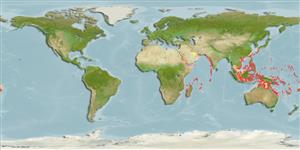Common names from other countries
Classification / Names / Names
Nomi Comuni | Sinonimi | Catalog of Fishes (gen., sp.) | ITIS | CoL | WoRMS
Environment: milieu / climate zone / depth range / distribution range
Ecologia
Associati a barriera corallina; distribuzione batimetrica 0 - 47 m (Ref. 8294). Tropical; 36°N - 34°S, 26°E - 137°W (Ref. 848)
Indo-Pacific.
Length at first maturity / Size / Peso / Age
Maturity: Lm ? range ? - ? cm
Colony: massive, either rounded or hillocky, sometimes over 1 m across. Corallites: rounded, with thick walls. Septa: straight, with exsert teeth. Color: dark in turbid environments, otherwise pale brown with brown or green oral discs (Ref. 848).
Maximum depth from Ref. 107542. Found in most reef environments (Ref. 848).
Life cycle and mating behavior
Maturità | Riproduzione | Deposizione | Uova | Fecundity | Larve
Hermaphroditic (Ref. 113712). Mature gametes are shed into the coelenteron and spawned through the mouth. Life cycle: The zygote develops into a planktonic planula larva. Metamorphosis begins with early morphogenesis of tentacles, septa and pharynx before larval settlement on the aboral end (Ref. 833).
Ross, M.A. and G. Hodgson. 1981. (Ref. 8294)
IUCN Red List Status (Ref. 130435)
CITES status (Ref. 108899)
Not Evaluated
Human uses
| FishSource |
Strumenti
Fonti Internet
Estimates based on models
Preferred temperature
(Ref.
115969): 24.7 - 28.9, mean 27.6 (based on 422 cells).
Price category
Unknown.
